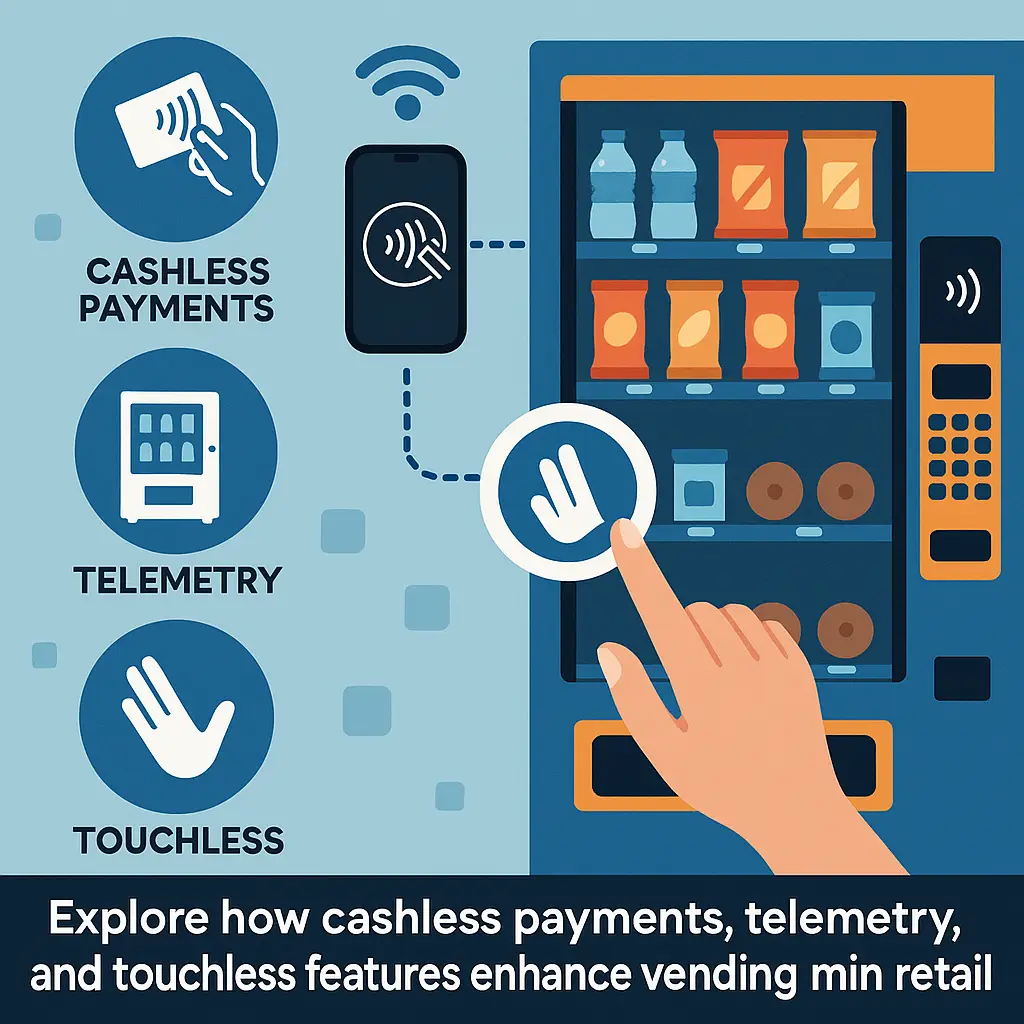Smart Technology in Retail Vending Machines
Explore how cashless payments, telemetry, and touchless features enhance vending machines in retail.
Back to Vending for Retail Locations ResourcesExplore how cashless payments, telemetry, and touchless features enhance vending machines in retail.
Back to Vending for Retail Locations ResourcesConnected vending blends convenience and insights: customers enjoy faster, touchless purchases while retailers gain real-time data to sharpen merchandising and operations.
![]() Cashless and contactless payments speed transactions and broaden purchasing options
Cashless and contactless payments speed transactions and broaden purchasing options
![]() Telemetry enables smarter restocking and reduces out-of-stock incidents
Telemetry enables smarter restocking and reduces out-of-stock incidents
![]() Touchless interfaces and app integration improve hygiene and customer confidence
Touchless interfaces and app integration improve hygiene and customer confidence

Retail environments demand speed, choice, and reliable service. Smart vending machines deliver on all three by combining modern payment methods, remote monitoring, and data-driven merchandising. These systems increase impulse purchases and keep customers satisfied with fewer service interruptions. Learn more about core components like cashless payments in our overview of cashless and contactless vending.
Accepting credit cards, mobile wallets, and NFC payments removes the barrier of needing exact change and shortens transaction times. Retailers often see higher average ticket sizes with card-accepting machines, and the digital receipts and transaction logs support accounting and promotions. Telemetry systems report inventory levels, sales velocity, and fault alerts. That visibility turns restocking into a targeted activity rather than a guess—reducing labor and minimizing lost sales from empty slots.
From QR-enabled product selection to app-based purchases and voice prompts, touchless features accommodate customer preferences and improve hygiene. These choices can also be integrated with loyalty programs or promotional offers to drive repeat visits. Explore ideas for customer-facing tech in retail vending trends.
Connected machines capture which SKUs sell best by time of day and location, enabling retailers to test assortments with minimal risk. Using simple dashboards, you can rotate offerings, introduce healthier choices, or niche snacks that suit your clientele. Learn merchandising tactics in our piece on data-driven merchandising for vending.
Smart units often include eco-friendly refrigeration settings, remote diagnostics, and secure payment processing that comply with industry standards. Remote alerts reduce unnecessary service calls and help maintain uptime. For guidance on maintenance and compliance, see vending machine maintenance.
Smart vending is an adaptable solution for small shops, large department stores, and mixed-use retail environments. To understand operational models and service arrangements, read our primer on full-service vending. If you want to evaluate options for your location, complete the form on this page to get started quickly.
Most accept credit/debit cards, NFC/mobile wallet payments (Apple Pay, Google Pay), and some support app-based purchases or closed-loop loyalty payments.
Telemetry reports inventory and sales in real time, allowing restocking teams to target machines that need attention instead of following fixed schedules.
No. Well-designed touchless features—QR scanning, app menus, or simple motion sensors—are intuitive and often faster than traditional interfaces.
Secure vending systems use PCI-compliant payment processors, encrypted data transmission, and authenticated device connections to protect transactions and sensitive data.
Yes. Connected machines can deliver time-based discounts, bundle offers, and integration with store loyalty programs to boost targeted sales.
Start with popular staples, review sales data regularly, and use telemetry to test and iterate assortments that match customer preferences and peak periods.
Installation is typically quick and non-invasive; machines need power and a suitable spot, and many vendors handle placement and setup to minimize disruption.
Choose machines with reachable controls, clear labeling, and alternative interfaces (audio, app control) to ensure accessibility for all customers.
Most connected systems receive remote updates from providers; these updates improve features, fix bugs, and maintain security without on-site intervention.
Key metrics include sales per SKU, sell-through rates, transaction value, machine uptime, and peak purchase times—data that informs inventory and placement decisions.